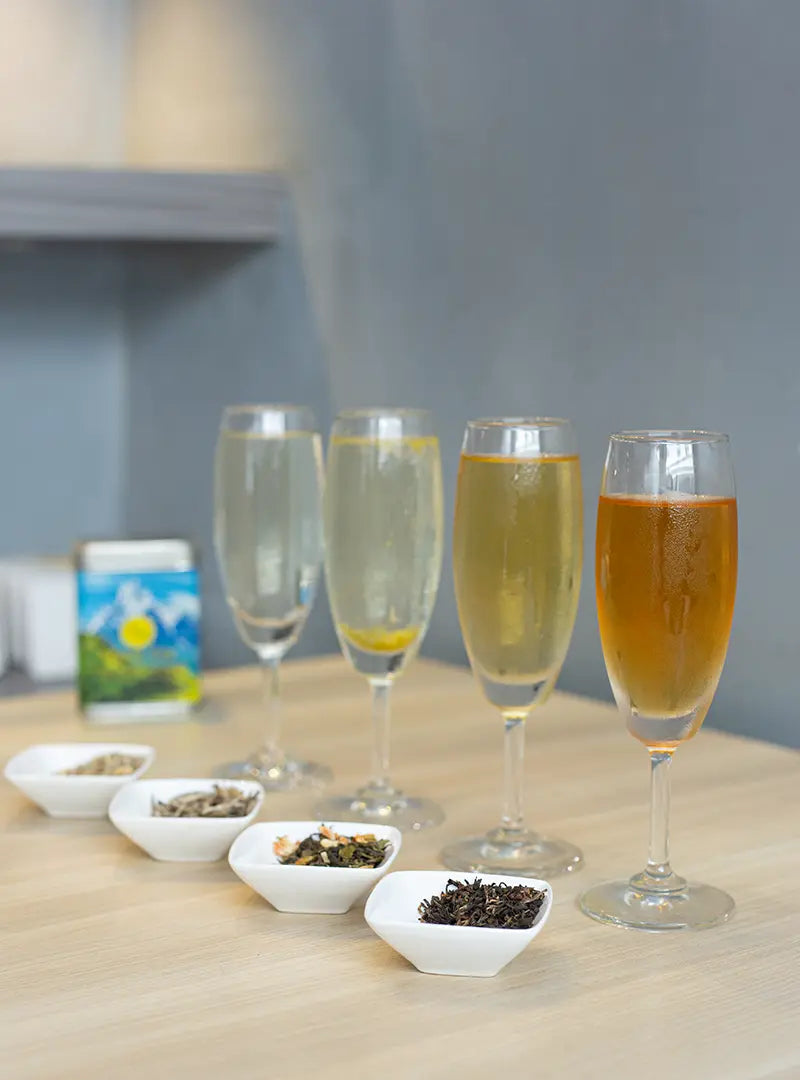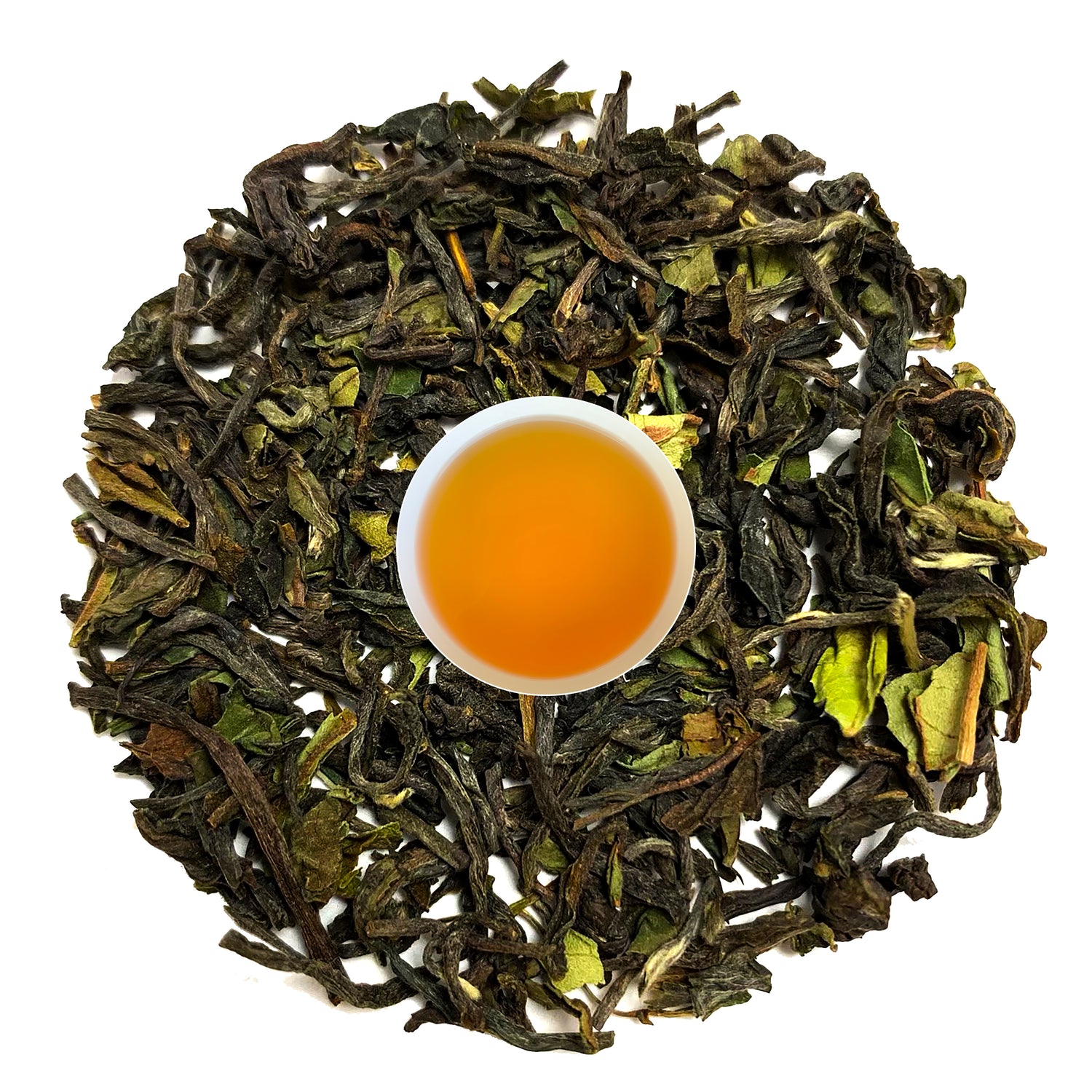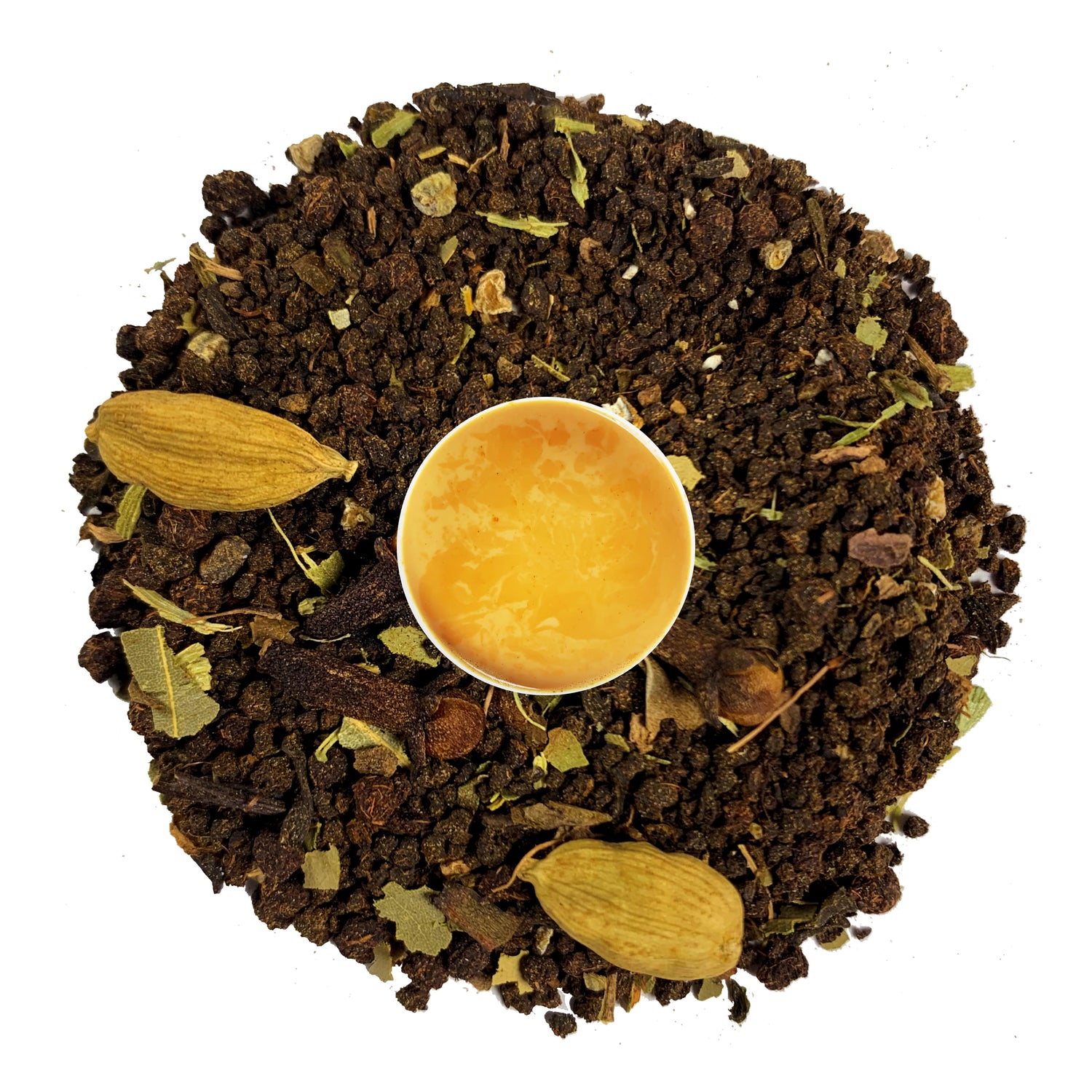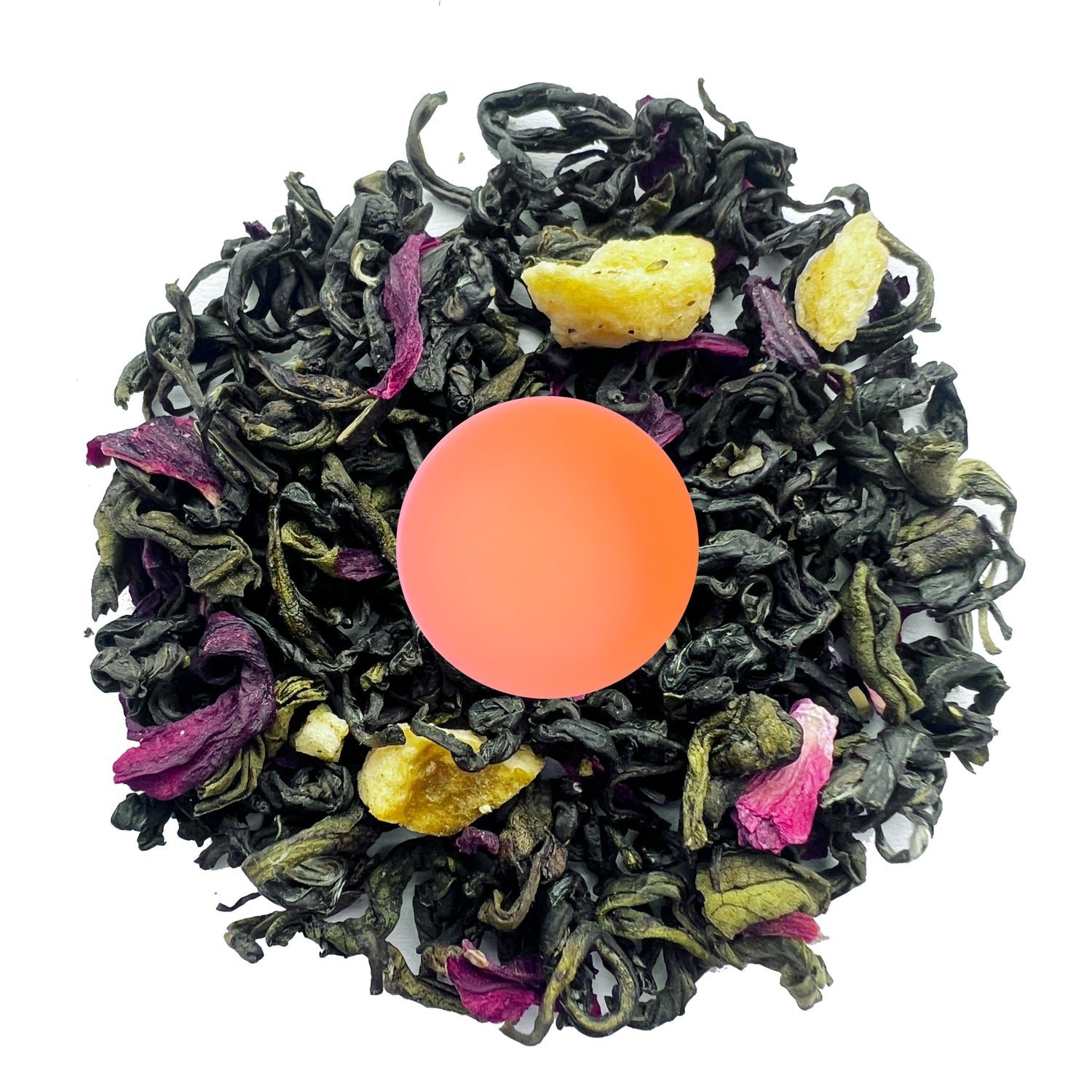128° Mt. Pumori Golden Tips Tea – USDA Certified Organic
128° Mt. Pumori Golden Tips Tea – USDA Certified Organic
Couldn't load pickup availability
Tea Name: 128° Mt. Pumori Golden Tips Tea – USDA Certified Organic
Style: One Leaf & a Bud, Golden-Tippy
Type: Organic Black Tea
Standard: Gold
Sourcing Region: Ilam, Nepal
Elevation: ~6,500 ft
Harvest: Autumn Flush
Processing: Fully Oxidized
Certifications: USDA Organic
Suggested Infusions: 4-5
Texture: Velvety, Nutty & Creamy
Autumn flush elegance from the Himalayas — golden-tipped, creamy, and gently spiced.
From the cool, high ridges of Ilam, Nepal (~6,500 ft) comes an autumn flush tea that glows like mountain gold. Hand-plucked as one leaf and a bud, its golden-tipped leaves are rich in natural theaflavins that yield a deep amber liquor of remarkable thickness and luster.
The cup opens with aromas of caramelized honey and toasted cashew, followed by gentle undertones of floral malt, dried apricot, and Himalayan wood spice. The mouthfeel is full-bodied and velvety, coating the palate with a creamy sweetness that lingers long after each sip. This is the kind of tea that speaks in layers — nutty warmth at first, a faint floral bloom in the middle, and a soft, buttery close that feels almost meditative.
While Darjeeling teas have long been celebrated for their elegance, Ilam’s higher elevation gardens bring a different level of clarity and depth. The cooler air, younger tea bushes, and chemical-free organic cultivation yield a cup that feels both purer and more alive — a natural evolution of Himalayan terroir, crafted not from colonial legacy but from democratized, grower-owned estates that honor both land and leaf.
A true expression of Himalayan autumn, crafted organically and by hand, it captures the rare stillness when cool mountain air meets golden harvest light — a moment that can only happen at the very top of the world.
Aroma & Appearance
Slender ribbons streaked with warm gold release aromas of honeyed malt, toasted cashew, and spring wood. In the cup: clear amber-gold with exceptional polish.
Taste Experience
-
Aroma: warm honey, roasted nuts, hints of cocoa and oak
-
Liquor: radiant amber-gold with a dense, satin-like body
-
Taste: creamy malt and cashew with whispers of apricot and light spice
-
Mouthfeel: thick, velvety, and indulgently smooth
-
Finish: lingering sweetness with a mineral lift, leaving a golden afterglow
Why It’s Special
-
Higher Elevation Terroir (~6,500 ft): cooler temperatures and thinner air slow the growth of tea leaves, intensifying amino acids and sugars for naturally sweet, full-bodied cups that surpass even exceptional Himalayan teas like Darjeeling in depth and clarity.
-
Young, Vibrant Tea Gardens: grown from youthful bushes at their flavor peak — producing leaves with more chlorophyll, antioxidants, and golden tips.
-
Organic Farming, No Compromise: USDA Certified Organic — free from chemical fertilizers or pesticides, letting the tea’s natural terroir shine through with mineral-rich precision.
-
Democratized Himalayan Estates: sourced from independent growers and cooperatives who focus on sustainability and community rather than large-scale industrial production.
-
Golden Bud Craftsmanship: abundant golden tips give a thick, satin-textured liquor with notes of honeyed malt, toasted cashew, and soft fruit sweetness.
-
Autumn Flush Sweetness: cool nights and crisp mountain air create an ideal sugar concentration in each bud, resulting in a cup that’s creamy, mellow, and deeply satisfying.
Brewing Recommendations
-
Leaf: 2–2.5 g (≈1½ tsp) per 8–10 oz (240–300 ml)
-
Water: 205 °F / 96 °C
-
Time: 3–4 minutes (3:00 for silkier; 4:00 for deeper malt)
-
Re-steeps: 2–3; add 30–45 sec each infusion
-
Milk pairing: a splash of warm milk accentuates malt & butterscotch—no sweetener needed.
The taste profiles of loose-leaf teas can vary widely depending on the steep duration, tea-to-water ratio, and water temperature. We encourage you to try different combinations for brewing tea to find the perfect tea, that speaks to your taste buds.
Save 10% with a Tea Subscription
With our tea subscription, you can enjoy a hassle-free monthly delivery of your favorite teas and save money! Cancel anytime!













The Tea Mystic Says
From the golden slopes of Ilam, Nepal, where the air thins and time itself slows, comes a tea that feels almost alive in the cup. The leaves — greenish-brown with copper and gold downy tips — breathe out aromas of wild raspberries, rose petals, and milky malt even before water touches them.
When steeped, they release a deep amber-caramel liquor with a thick, brothy texture — smooth yet powerful, like liquid mountain light. The first sip carries a gentle herbaceous sweetness, unfolding into dark chocolate and warm caramel undertones, each layer revealing itself more slowly with every breath.
As the liquor cools, a faint minty dryness emerges, clearing the palate and leaving behind a calm, lucid energy — the kind of clarity only high-mountain air can give. Drink two or more infusions, and you’ll feel that unmistakable Himalayan tea high — grounded, weightless, and quietly enchanted.
It’s the autumn heartbeat of the Himalayas — bold, elegant, and impossibly serene.
Methods to Brew Tea
We believe that your tea experience should be completely personal. Individual taste buds are unique and there is no right or wrong way to brew tea. Therefore we encourage tea lovers to not necessarily bind to traditional methods but let their experience, and discovery guide them. After all, that is where the joy of drinking tea lies. You should try different amounts of tea, steeping time, and water temperature to find the perfect taste you’ll fall in love with.
-
Mild-Smooth
- Get 10 oz filtered water and bring it to a boil.
- Add about 1 teaspoon of tea buds into a clear glass or in your Steeping cup.
- Pour the boiling hot water into your clear glass or steeping cup containing tea buds.
- Let it steep for 4 minutes.
- The color is light golden. Strain and enjoy every sip of it.
- Repeat for the second infusion.
-
Robust-Energizing
- Get 10 oz filtered water and bring it to a boil.
- Add about 1.5 teaspoons of tea buds into a clear glass or in your Steeping cup.
- Pour the boiling hot water into your clear glass or steeping cup containing tea buds.
- Let it steep for 6 minutes.
- The color is Dark golden. Strain and enjoy every sip of it.
- Repeat for the second infusion.

Iced teas
Can you make sweet/ unsweet iced teas from loose-leaf teas?
Of course, you can! High-quality loose-leaf teas make the most refreshing iced teas—smooth, crisp, and oh-so-quenching!
While some might call it blasphemous to add sweetener/sugar to high-quality loose-leaf teas, here in Texas, where sweet iced tea is a beloved tradition, we have been using our loose-leaf to uplift the iced tea experience.
We have tried and perfected the art of turning your favorite loose-leaf tea into a delicious iced delight.
It's time to try it for yourself. Here's how we do it:
Pro tip: Feel free to experiment with water amounts, temperature, steeping time, tea quantity, and sweetener quantity to find your perfect balance.
Steep suggestions for iced teas:
Amount of Water: 2 Liters
Amount of Loose Tea: 10-12 grams (5-6 teaspoons)
Steeping Time: 15-20 minutes
Steeping Temperature: 190-2000°F
| Steps to Brew Iced Tea: |
|---|
| Step 1: Start with a 2-liter batch. Boil water, then remove it from heat. Let it cool for 1-2 minutes until it's around 190-200°F. |
| Step 2: Add loose-leaf tea. Add 10 to 12 grams of your favorite loose-leaf tea OR 5 to 6 teaspoons. |
| Step 3: Steep the tea. Steep for 15-20 minutes (or longer if you prefer a stronger brew). |
| Step 4: Strain and cool. Strain the tea, then let it cool down. Add ice. (Pro tip: For best flavor, let it chill in the fridge for a few hours or overnight. Add ice when you drink.) |
| Step 5: Sweeten to taste. Add your favorite sweetener, but remember that balance is key—don’t let the sweetener overpower the tea’s flavor. (Pro tip: As you sip, let the tea linger in your mouth for a couple of seconds to fully enjoy its rich flavors.) |
FAQs
Frequently Asked Questions
What makes Mt. Pumori Golden Tips Tea different from Darjeeling teas?
Most Darjeeling gardens lie between 3,000 and 5,800 ft, while Nepal's Ilam plantations rise to about 6,300 – 6,600 ft above sea level — roughly 500 to 1,000 ft higher on average.
At this height, cooler nights and thinner air slow the plant’s metabolism, allowing amino acids and aromatic compounds to build naturally. The result is a cup that’s creamier, less brisk, and more layered, with a smooth malt-honey body that lingers far longer than typical Darjeeling profiles.
How rare is this tea?
This golden-tippy autumn flush makes up less than 2% of Ilam’s total black-tea output. Each kilogram requires around 4,800 – 5,200 buds and tender leaves, all hand-plucked within a brief two-week harvest window in late autumn when leaf sap is thickest. The limited yield and manual selection make it one of the most exclusive high-elevation black teas in the Himalayas.
What is the caffeine and L-theanine content?
An 8 oz cup contains about 50–55 mg of caffeine and 18–22 mg of L-theanine.
That 2.5 : 1 ratio produces focused clarity without the caffeine crash — a calm, sustained energy that connoisseurs prize in high-mountain teas.
Why does it taste so creamy and thick?
The tea’s signature texture comes from its balanced theaflavin (~90 mg/cup) and thearubigin (~220 mg/cup) composition, achieved through slower oxidation in the cool Ilam climate.
This chemistry, coupled with natural amino acids from first-flush buds, yields a velvety liquor with a honeyed malt depth — thicker than most mid-altitude Himalayan teas.
How does high elevation influence flavor?
At ~6,500 ft, each 1 °C drop in mean temperature slows photosynthesis by ~6%.
This concentrates:
- Amino acids (+15 % vs low-altitude teas) → sweetness & umami
- Volatile esters (+20 %) → floral & nutty aromas
- Reduced catechins (−10 %) → less bitterness
Together they create a smoother, more aromatic cup — naturally sweet with mineral purity and floral nuance.
What flavor notes should I expect?
Primary notes of caramelized honey and toasted cashew, followed by hints of dried apricot and Himalayan malt, finishing with a buttery, woody sweetness that lingers for minutes.
How antioxidant-rich is this tea?
Each cup delivers roughly 400–420 mg of polyphenols (theaflavins, thearubigins, catechins) — about 15–20 % higher than standard Darjeeling autumn flushes.
The region’s mineral-rich volcanic soil also contributes trace elements such as manganese, zinc, and magnesium, which enhance both antioxidant stability and mouthfeel.
What makes the autumn flush special?
The October–November harvest is marked by lower humidity and cooler nights, which reduce leaf moisture and concentrate sap sugars. This yields a liquor that’s dense, honey-mellow, and naturally sweet, with a calm, satisfying body ideal for mindful sipping.
How do I brew it for the richest experience?
- Tea: 2.5 g (≈ 1½ tsp) per 8 oz water
- Water Temp: 205 °F (96 °C)
- Steep Time: 3½ – 4 min (first infusion); add 30 sec for subsequent brews
- Infusions: Up to 3; the second brings out more nutty warmth
- Best Water: Spring or filtered soft water (< 100 ppm TDS)
How long does it stay fresh?
Stored airtight and cool (< 70 °F / 21 °C), the tea keeps peak aroma and sweetness for 18–24 months. Its low moisture content (~2.8 %) and natural antioxidant density make it more stable than most mid-altitude teas.
Discover More Types of Teas
-

Best Black Teas from the Himalayas
Discover the list of best black teas from the Himalayas.
-

Asian Herbal Tea and Blends
Asian herbal teas and blends are one of the most sought-after teas...
-

Detox Teas - Nepal Tea Blends & Tisanes
Feel the warmth and charm of the Himalayas with our handpicked collection...


















